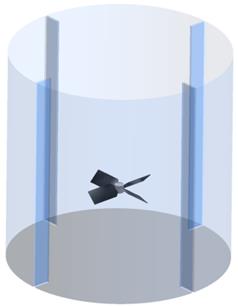28 Aug Baffle Basics (Round Vessels)
Tank baffles are devices added to the inside of a vessel near the vessel wall. Their main purpose is to reduce the tangential velocity component of the total velocity field imparted on the fluid by a mixing impeller. This results in top to bottom fluid turnover within the vessel, which is essential for most mixing applications. Without baffles, the time to blend materials together increases substantially and the ability to suspend solids off the bottom of the vessel is significantly reduced.
A standard baffle set up is shown above for a round vessel with a mixer installed on center (Figure 1). For round vessels, baffles are essential for most applications. The standard baffle design parameters are as follows:
- Number of Baffles and Baffle Width: The default number of baffles is four (4). Impeller characterization (i.e. power response and flow response) is always carried out in a vessel that has four standard width baffles (width = 1/12th of the tank diameter).
- Baffle Off Wall Dimension: Although the baffles in the figure below are shown right up against the tank wall, it is best practice to extend the baffles off wall a certain distance. This will prevent any of the material in the tank from building up near the baffle/wall interface. The standard distance for this is 1/36th of the tank diameter. For very large vessels (greater than 12 m or 40 ft.), this dimension gets large and supporting the baffles might become difficult. Thus in good practice, target a 12 inch (300 mm) gap as a minimum for larger vessels.
- Baffle Off Bottom Dimension / Liquid Coverage: This dimension is generally set to zero as a default. In practice, it is good to raise the baffles off the bottom of a flat bottom tank in order to prevent material build up at the baffle/floor interface. In addition, it becomes important to extend the baffles into a dished or cone bottom depending on how many impellers operate in this area of the tank. A rule of thumb for this off bottom distance in a flat bottom vessel is a 12 to 24 inch (300 mm to 600 mm). The same rule of thumb can be applied for liquid coverage over the top of the baffle. The reason for lowering the baffle below the liquid surface is to prevent fluid stagnation near the baffle/surface interface, which can lead to material build near the baffle. Baffles can be lowered even further if an upper impeller is being designed to pull a vortex.
Learn more about Lightnin SPX mixers and access the tank calculator.



